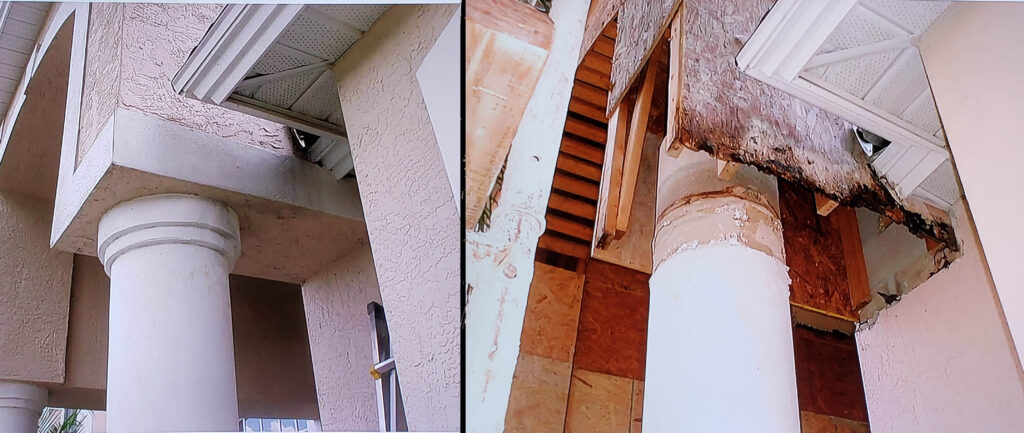
It is hiding, creeping, and eating away at your biggest investment. It isn’t termites. It isn’t critters. It is water damage and dry rot.
Our Sacramento home inspections have found any home can be vulnerable to water leaks and flooding. Dealing with water damage can be expensive and sometimes affect your health.
Sometimes water damage is immediately visible, like when the roof leaks and the ceiling drips. But usually water damage builds up over time; and the organisms it carries are busy feeding on your wood and insulation.
The best defense is a good offense Because, once water enters your home, it can be difficult to remove.
Some common examples of damage from water intrusion our house inspectors see are:
– Improperly installed and maintained stucco.
– Blockages or improperly sealed joints in condensation drain pipes for HVAC systems
– Window shutters where screwed or nails penetrate exterior siding
– Trim around doors and windows
– Butt joints for wood siding or engineered wood siding
– Mounts, fasteners, and drilled holes caused by improper installation of satellite dishes, cable, and phone lines.
Look at these 5 maintenance tips to help keep your house dry and your foundation strong.
1. Caulking & Sealing. Everywhere something is installed or stuck to the exterior siding of your home, or penetrates your roof, is an opportunity for water intrusion and damage.
A vent. A chimney. A skylight. Or anything (trim, siding, shutters, equipment) that is nailed, screwed, on or butts up against another object, is an opportunity for water intrusion when moisture is present. Also, think about where the sprinklers hit the house, or when washing the car splashes water onto the house. These all create opportunities for water damage.
Every year, before the rainy season, you should be up on a ladder inspecting metal flashing for damage, clearing out debris, and looking at flexible seals (caulking, rubberized seals), for cracks or other damage.
Seal up those trim pieces and butt joints with a paintable silicon based caulking. Silicon caulking comes in many colors (or clear), and lasts for decades in harsh weather conditions. You get what you pay for, so pay a little more to get high quality caulking.
Good quality exterior primer and paint are important. In our experience as home inspectors, for our own projects we personally prefer Alkyd style paints as opposed latex / enamel paints. Alkyd paints flow well and stand up to abuse like oil based paints and primers. Alkyd paints can be thought of as a hybrid between oil-based and latex / enamel paints, with resins in it that dry durable and resistant to wear. Alkyd paints are available at your local hardware store, so just ask.
2. Clean your gutters. It might seem obvious, but most people forget about gutters. To properly work, gutters must be free of leaves, moss, nests and other debris. Clean your gutters regularly or they may could fill up and spill water over onto your eaves and fascia, down the sides and onto the foundation of your house instead of carrying water safely away.
3. Watch for signs of a leak. Sometimes pipes are stresses and joints spring a leak, or pipes decay and start dripping. Did you know that cast iron drain /waste pipes in all homes 50+ years old are now past their service life, and may be leaking gray or brown water beneath your home?
Mold and termites seek out moist environments. Identifying and promptly repairing potential water leaks, paying attention to any upticks in your water bill, listening for dripping sounds, and occasionally looking under your home at the plumbing, are well worth the effort. Look for physical signs of trouble, like dark spots around pipes, edges of your windows, or ceiling stains.
You might also invest in a smart water leak sensor to detect hidden leaks and alert you when there’s an issue.
4. Avoid chemical drain cleaners. Most homes have some form of metal drain pipe system (cash iron, galvanized steel). Strong chemicals can erode your pipes and cause leaks. Drain snakes are inexpensive, and easy to use. They are effective, and better for your health and the environment.
5. Insulate your pipes. Water expands when it freezes, sometimes bursting pipes. But there are ways to avoid bursting pipes. If you leave faucets dripping to give the water a place to go, or cover outdoor spigots with foam shields, be sure to take action before freezing weather hits.
Lastly, check your homeowners insurance. In addition to these preventive actions, make sure you know what your policy covers in the event you do have to file a claim.
Have questions? Call our home inspectors today at SacPro Home Inspections (916) 333-0540.
